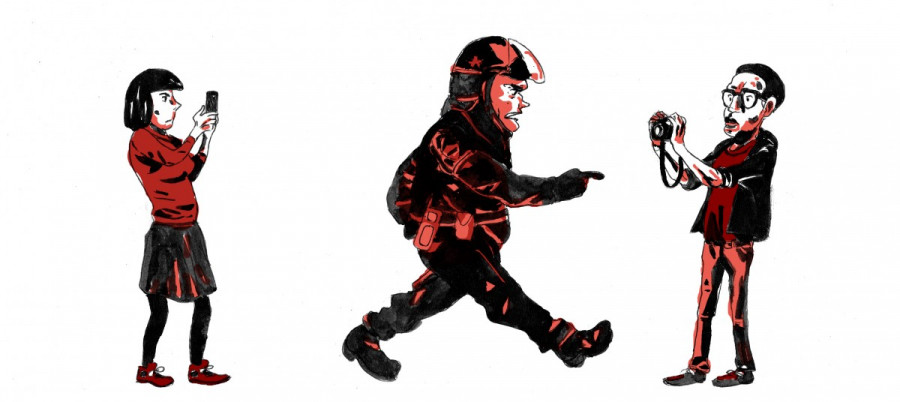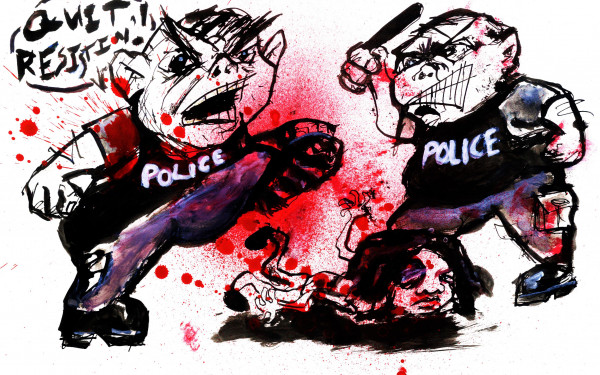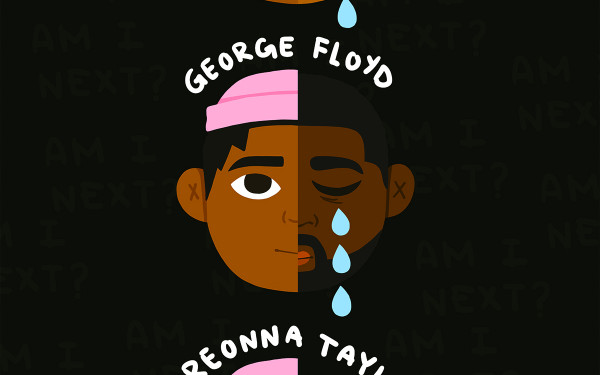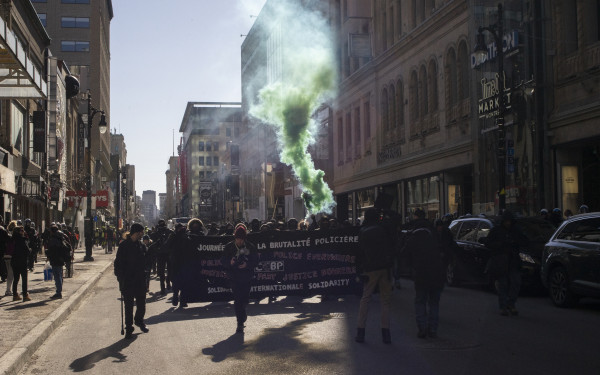Who Watches the Watchers?
How Filming the Police is Lawful and Necessary
All Media Democracy content is available on our Special Issue Microsite (works best on Chrome or Firefox).
In schools and workplaces, the concept of “if you see something, say something” is often employed to encourage transparency about peer misconduct.
But what if, at a protest or just during a night out on the town, you witnessed police brutality? What would you do?
The real question might be—what can you do?
With the fourth annual candlelight vigil for those killed by police officers held last week, and the notoriously hell-raising holiday Halloween coming up, police accountability should be on everyone’s minds.
Filming the police is something the average citizen is often hesitant to do—especially if said police are clad in all-black paramilitary tactical gear complete with a facemask and riot shield, something popping up more and more recently, from the Arab Spring, to the Occupy protests, to the 2012 Quebec student strikes.
This issue hits especially close to home with the recent P-6 bylaw controversy prohibiting protestors from wearing masks, while riot police as a rule cover their face and often conceal their badge numbers—and thus their identities—to protestors or concerned bystanders.
Right out of the gate, it should be known that it is not illegal for citizens to film public servants. Any claims to the contrary by police are false, confirmed Abby Deshman, director of the Canadian Civil Liberties Association’s public safety program.
“There is no law prohibiting people from filming police on duty in public spaces,” she said.
Deshman went on to say that such activities are constitutionally protected, with the Supreme Court upholding that journalists and citizens engaging in lawful newsgathering are protected under freedom of expression and freedom of the press.
Section 129 of the Criminal Code prohibits “willfully obstructing” police in the execution of their duty—but standing at a distance holding a camera does not, in fact, qualify as an obstruction.
“To date, I haven’t seen any cases in Canada where simply filming a police officer has been found to be obstructing their duty, and I would strongly argue that it couldn’t,” Deshman said.
But this often doesn’t stop police officers from responding to being filmed with violence, which is usually why citizens are filming them in the first place.
At the recent candlelight vigil, Montrealer Didier Berry spoke about his experience trying to lawfully and peacefully record SPVM officers and the violent repercussions.
“I was trying to film an arrest that I thought was unfair, at a distance,” Berry said.
“They never told me what I did wrong or notified me of my rights. They beat, insulted, and choked me until I lost consciousness.”
Deshman said that by disobeying a direct order from a police officer, you’d be opening yourself up to obstruction charges, even if such orders were not legitimate.
“Whether or not those charges would hold up in court […] is another question. I don’t know of any case law on this point in Canada, so it’s untested waters,” she said.
“My take would be that police ordering you to stop filming without some accentuating circumstances would not be a lawful order. You would not be guilty of obstruction for not following it,” she continued.
Badges Don’t Grant Extra Rights
The CCLA is just one of many civil liberties organizations in Canada and the U.S. that support the proactive filming of police. A group founded on this idea is Cop Block, a decentralized grassroots project born in the liberty-loving state of New Hampshire.
According to their website, the organization is dedicated to “documenting police actions whether they are illegal, immoral, or just a waste of time and resources, then putting direct pressure on the individuals responsible.”
James Carroll, an activist with Cop Block, says filming police is “all about transparency,” and that it’s “an exercise of freedom.”
Critics of Cop Block are often quick to claim activists just hate cops for personal reasons, and that their concerns aren’t valid.
“I think it’s very reasonable for people to be wary of [police], and they have every right to be,” Carroll said.
“History shows how power corrupts and cops are human, therefore imperfect, just like everybody else.
“They should never be held above anybody simply because they have a public job in which they wear uniforms and a badge,” he continued.
“My take would be that police ordering you to stop filming […] would not be a lawful order.” — Abby Deshman, Canadian Civil Liberties Association
But police accountability doesn’t have to come only from citizens’ cameras, either—the practice of police wearing lapel cameras to constantly record their actions while on duty is now becoming more commonplace.
The police department in Rialto, California utilized the program and the city saw an 88 per cent drop in complaints against police officers in the first year, according to The New York Times.
“When you put a camera on a police officer, they tend to behave a little better, follow the rules a little better,” Rialto’s police chief, William A. Farrar, told The Times.
“And if a citizen knows the officer is wearing a camera, chances are the citizen will behave a little better.”
Deshman is open to the idea but questions the details of the program, like who would review the footage, and whether the officers are able to turn off the camera at will.
“It’s a complex proposal,” she said. “We know that video can be an incredibly powerful accountability tool, [but] we also know it can be incredibly privacy-invasive.”
Carroll supports the idea as well, but was quick to mention that almost all traffic stops are recorded with dashcams and that there are still thousands of police abuse cases reported every year.
Weapons of War in the Streets
Organizers of last week’s vigil reported that Montreal police officers killed 11 citizens in the last five years alone, whether in stand-offs, car crashes or unprovoked shootings.
As for militarized police responses to protests and rallies, Deshman said a visible display of force by the police is counter-productive and will only make matters worse.
“We know from multiple studies that if police arrive at a protest wearing full hard-tactical gear and openly carrying heavy duty weaponry that it escalates the situation,” she said.
But even without the frightening bells and whistles of militarized police, everyday encounters such as traffic stops with regular officers can still lead to citizens feeling intimated.
An unlawful order barked from a police officer in the heat of the moment to turn off your camera may strike fear in you, and based on precedents, not complying could result in illegal detention, or even a physical assault by the officer.
But Deshman said that citizens participating in accountability measures are crucial in stopping police abuse, emphasizing the importance of monitoring practices.
“We know that video evidence of police misconduct is often the most compelling evidence that you can put forward,” she said.
“We’re seeing multiple police officers being brought to charges on the basis of citizen video and photography.”
Shining the light of accountability onto the select officers accustomed to abusing their power has become our responsibility as citizens. We need to peacefully combat police brutality and bring justice to the victims of police violence with the lenses’ all-seeing eye. We need to keep the cameras rolling—no matter what.
— With files from Geoffrey Vendeville


_600_832_s.png)


_1_600_375_90_s_c1.jpg)

